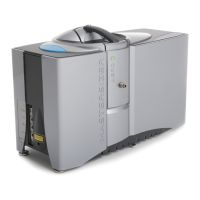Chapter 5 Viewing measurement results
Page 5-20 MAN 0474
skewness
kurtosis
In the above formulae K and X depend on the distribution being calculated as
shown in this table:
The various derived diameters are related by:
For “mono-size” distributions such as latex, the distribution mean is reported as
the geometric mean of the size class and standard deviation, skewness and kur-
tosis are reported as zero.
The procedure used for other parameters of the distribution is to create a spline fit
to the fundamental result. Intermediate values are then read from this curve allow-
ing interpolation of percentile points which do not coincide with the measurement
size band boundaries.
Distribution K
X
i
Volume 3 V
i
Surface 2 V
i
/d
i
Length 1
V
i
/d
i
2
Number 0
V
i
/d
i
3
Skew
X
i
d
i
d–
3
3
X
i
----------------------------------
DK 3 K+
3
dd
2
3
2
+–
3
------------------------------------------------------------------------
==
Kurt
X
i
d
i
d–
4
4
X
i
----------------------------------
3–
DK 4 K+
4
d 4DK 3 K+
3
3d
3
6d
2
++–
4
-------------------------------------------------------------------------------------------------------------------------
3–==
Dmn
mn–
Dm0
m
Dn0
n
-----------------------
=

